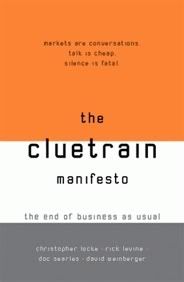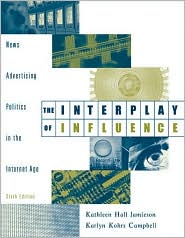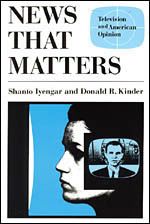12/28/2007
Book Review: We the Media
 Dan Gillmor says the moment everything changed for him was when he noticed a small button at the bottom of a web page that said "edit this page". Unlike most typical technophiles, Gillmor is concerned foremost with the human side of things - not the technology behind the button, but the impact it could have on society. For this reason, he is well-suited to write a synopsis of the technological breakthroughs that have allowed ordinary citizens to stand up to "Big Media" and become their own information outlets. Although written in 2004, We the Media is a good account of the revolution of citizen-journalism that has occurred through blogs and other devices. Gillmor is a journalist himself, but he believes the ordinary blogger has the ability to make journalism better, breaking it out of the mold of institutionalism and corporate governance. His idea of a new "renaissance" would be a "truly informed citizenry". Gillmor might be seen as a traitor to journalism, or its savior. Either way, the book is generally loved by bloggers, not to mention that is free on the web. Gillmor makes the point that technology is "relentless and unstoppable", touching upon Metcalfe's law to show that the web is becoming more valuable as more users take part. The more numerous its "nodes" are the richer its supply of information and abilities will be. The value of the web will inevitably overrule mass media sources like the TV and newspaper. However, Gillmor does not imagine the web being able to replace live TV for coverage of events, citing bandwidth costs. But the explosion of YouTube following the book's writing proves this case is weak. YouTube Live! is not a far-off concept. Nevertheless, Gillmor has written a book that bloggers can find empowering yet not totally self-indulgent. Gillmor is aware of the pitfalls of news and information coming from the bottom-up. But he believes the dismantling of authoritarian mass-media control of the news is truly democracy-in-action. I share his notion that we might be at the tip of a renaissance. In the same way the value of the web increases with its involvement, the value of society and government could grow as ordinary citizens continue to dramatically take part in ways impossible without an editable web. As Gillmor concedes:
Dan Gillmor says the moment everything changed for him was when he noticed a small button at the bottom of a web page that said "edit this page". Unlike most typical technophiles, Gillmor is concerned foremost with the human side of things - not the technology behind the button, but the impact it could have on society. For this reason, he is well-suited to write a synopsis of the technological breakthroughs that have allowed ordinary citizens to stand up to "Big Media" and become their own information outlets. Although written in 2004, We the Media is a good account of the revolution of citizen-journalism that has occurred through blogs and other devices. Gillmor is a journalist himself, but he believes the ordinary blogger has the ability to make journalism better, breaking it out of the mold of institutionalism and corporate governance. His idea of a new "renaissance" would be a "truly informed citizenry". Gillmor might be seen as a traitor to journalism, or its savior. Either way, the book is generally loved by bloggers, not to mention that is free on the web. Gillmor makes the point that technology is "relentless and unstoppable", touching upon Metcalfe's law to show that the web is becoming more valuable as more users take part. The more numerous its "nodes" are the richer its supply of information and abilities will be. The value of the web will inevitably overrule mass media sources like the TV and newspaper. However, Gillmor does not imagine the web being able to replace live TV for coverage of events, citing bandwidth costs. But the explosion of YouTube following the book's writing proves this case is weak. YouTube Live! is not a far-off concept. Nevertheless, Gillmor has written a book that bloggers can find empowering yet not totally self-indulgent. Gillmor is aware of the pitfalls of news and information coming from the bottom-up. But he believes the dismantling of authoritarian mass-media control of the news is truly democracy-in-action. I share his notion that we might be at the tip of a renaissance. In the same way the value of the web increases with its involvement, the value of society and government could grow as ordinary citizens continue to dramatically take part in ways impossible without an editable web. As Gillmor concedes: Only one thing is certain: we'll all be astounded by what's to come.


 In 1517, Martin Luther posted his
In 1517, Martin Luther posted his  I just had the honor of reading a book published in 1988 called
I just had the honor of reading a book published in 1988 called  In 2000, at the peak of the dot-com bubble, Seth Godin wrote
In 2000, at the peak of the dot-com bubble, Seth Godin wrote  Has Facebook not learned anything? The whole point of Web 2.0 is that we won't play this game anymore. Sure, Facebook may be a "foundation and process where people can market to each other", but they forgot to part about getting out of the way. Do they think they can skirt the rules of marketing 2.0 and exploit their network of users with artificial ideaviruses? This insults the core ideavirus that is Facebook. It works because people can communicate for free and link to each other just for the Hell of it. When a viral craze like
Has Facebook not learned anything? The whole point of Web 2.0 is that we won't play this game anymore. Sure, Facebook may be a "foundation and process where people can market to each other", but they forgot to part about getting out of the way. Do they think they can skirt the rules of marketing 2.0 and exploit their network of users with artificial ideaviruses? This insults the core ideavirus that is Facebook. It works because people can communicate for free and link to each other just for the Hell of it. When a viral craze like  The exhaustive experiments and surveying conducted by Shanto Iyengar and Donald Kinder in the late 1970s and early to mid 1980s conclude that television news certainly impacts public opinion - not telling people what to think, but telling them what
The exhaustive experiments and surveying conducted by Shanto Iyengar and Donald Kinder in the late 1970s and early to mid 1980s conclude that television news certainly impacts public opinion - not telling people what to think, but telling them what